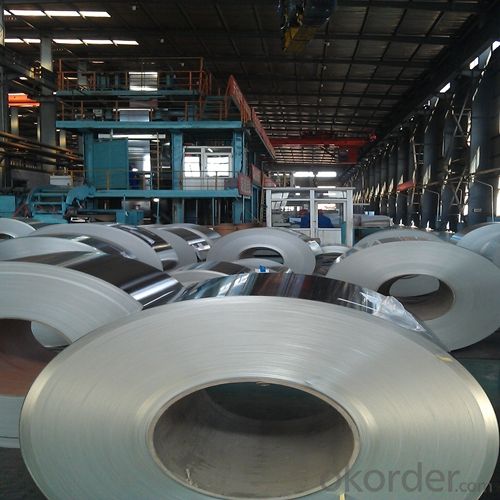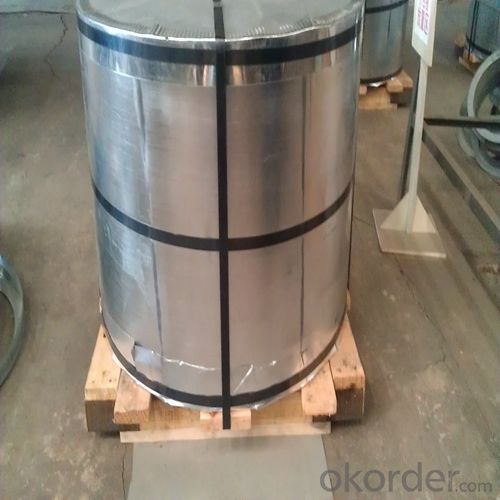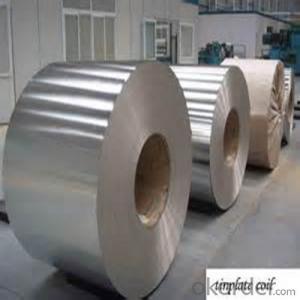Prime Good Quality Tin Free Steel for Metal Cans
- Loading Port:
- Shanghai
- Payment Terms:
- TT OR LC
- Min Order Qty:
- 25 m.t.
- Supply Capability:
- 25000 m.t./month
OKorder Service Pledge
OKorder Financial Service
You Might Also Like
Item specifice
1.Structure of Prime Good Quality Tin Free Steel for Metal Cans Description
Also known as chromed steel, tin-free steel (TFS) is obtained by coating the metal base (low-carbon steel) with an ultra-thin layer of metallic chrome and then with a chromium oxide layer.
The product complies with ASTM A-657 Specification and is manufactured with low current density (TFS-III) and is supplied in coils (up to 12 metric tons)or sheets.
2.Main Features of the Prime Good Quality Tin Free Steel for Metal Cans
Filiform Rust Resistance: Filiform is superficial corrosion of the base metal. TFS has a superior base metal which makes it corrosion resistance.
Coating: The coating in TFS is not amphoteric (having the characteristic of an acid and a base, is a compound that can react as either an acid or a base). This means that detergents and dispersion colors can be packed easily.
Paint Adhesion : TFS possesses better paint adhesion properties, thus making it ideal for DRD cans and adhesive bonded cans.
Weldability: TFS can be welded when metallic coating layers are removed by edge grinding.
TFS should be Lacquered / Coated to prevent rust in humid condition.
Internal Coating / Lacquering can be avoided in the case of TFS used to store motor oil or cooking oil.
3.Prime Good Quality Tin Free Steel for Metal Cans Images



4.Prime Good Quality Tin Free Steel for Metal Cans Specification
Material: MR,SPCC
Thickness:0.15mm - 0.50mm
Width: 600mm -1150mm
Temper: T1-T5
Annealing: BA & CA
Coil Inner Diameter: 508mm
Weight: 6-10 tons/coil 1~1.7 tons/sheets bundle
Oil: DOS
Surface: Finish,bright,stone,matte,silver
5.FAQ of Prime Good Quality Tin Free Steel for Metal Cans
-What is MOQ?
Our MOQ would be 25 tons
- How many types there are for base steels?
The base steels are of three types: Type MR, L, D
- Q:How does tinplate contribute to the containment of chemical substances?
- Tinplate contributes to the containment of chemical substances by providing a protective barrier against corrosion and contamination. It is a durable and impermeable material that prevents the interaction between the chemical substances and the surrounding environment, ensuring their integrity and safety.
- Q:What are the main challenges in the recycling of tinplate?
- Some of the main challenges in the recycling of tinplate include the separation of tin and steel components, as well as the removal of any contaminants or coatings on the surface of the tinplate. The varying thickness and composition of tinplate can also pose challenges during the recycling process. Additionally, ensuring the collection and proper disposal of tinplate waste from various sources can be a logistical challenge.
- Q:What are the recycling processes for tinplate?
- The recycling processes for tinplate typically involve several steps. First, the tinplate is collected from various sources, such as households or businesses. Then, it is sorted and separated from other materials, such as paper or plastic, through manual or mechanical means. Next, the tinplate is cleaned to remove any contaminants, such as labels or food residue. After cleaning, the tinplate is shredded or melted to reduce it to smaller pieces or molten metal. The molten metal is then cast into new tinplate sheets or other products. This process helps conserve resources, reduce waste, and minimize the environmental impact of tinplate production.
- Q:What are the main growth opportunities for the tinplate industry?
- Some of the main growth opportunities for the tinplate industry include expanding into emerging markets, such as Asia and Africa, where there is a growing demand for packaged food and beverages. Additionally, the increasing focus on sustainable packaging solutions presents an opportunity for tinplate manufacturers to develop eco-friendly alternatives. Moreover, advancements in technology and automation can enhance production efficiency and allow the industry to cater to a wider range of customers. Lastly, the rise of e-commerce and online shopping could lead to increased demand for tinplate packaging for shipping and storage purposes.
- Q:What are the typical lead times for tinplate production?
- The typical lead times for tinplate production can vary depending on factors such as the quantity required, complexity of the design, and the manufacturer's production capacity. However, on average, lead times for tinplate production usually range from several weeks to a few months.
- Q:How is tinplate made?
- Tinplate is made by coating thin sheets of steel with a layer of tin through a process called electroplating. The steel sheets are first cleaned and then passed through an electrolyte bath containing tin salts. An electric current is then passed through the bath, causing the tin ions to bond with the steel surface, forming a uniform layer of tin. This tin coating provides corrosion resistance and enhances the appearance of the steel, making it suitable for various applications such as food and beverage packaging.
- Q:Can tinplate be used for construction applications?
- Yes, tinplate can be used for construction applications. It is commonly used for roofing, cladding, and siding due to its durability, corrosion resistance, and aesthetic appeal. Additionally, tinplate's lightweight nature makes it easier to handle and install in construction projects.
- Q:How is tinplate coated for corrosion resistance?
- Tinplate is coated for corrosion resistance through a process called electrolytic tinning. In this process, a thin layer of tin is deposited onto the surface of the tinplate using an electric current. This tin coating acts as a protective barrier, preventing the underlying steel from coming into direct contact with oxygen and moisture, which are the main causes of corrosion.
- Q:What are the applications of tinplate?
- Tinplate is commonly used in various applications due to its unique properties. It is primarily used in the packaging industry for food and beverage containers, as tin coating provides excellent protection against corrosion and ensures product safety. Tinplate is also utilized in the manufacturing of aerosol cans, paint containers, and metal closures. Its versatility extends to the automotive industry, where it is employed for making fuel tanks, oil filters, and various automotive components. Additionally, tinplate finds applications in the construction sector for roofing, ductwork, and HVAC systems.
- Q:What are the advantages of using tinplate for shipping containers?
- There are several advantages of using tinplate for shipping containers. Firstly, tinplate is highly durable and provides excellent protection against corrosion, ensuring the safety and integrity of the goods being transported. Secondly, tinplate is lightweight yet strong, making it easier to handle and transport containers efficiently. Additionally, tinplate is easily recyclable, making it an environmentally friendly choice. Lastly, tinplate has a smooth surface which can be easily cleaned and sanitized, reducing the risk of contamination during shipping.
1. Manufacturer Overview |
|
|---|---|
| Location | |
| Year Established | |
| Annual Output Value | |
| Main Markets | |
| Company Certifications | |
2. Manufacturer Certificates |
|
|---|---|
| a) Certification Name | |
| Range | |
| Reference | |
| Validity Period | |
3. Manufacturer Capability |
|
|---|---|
| a)Trade Capacity | |
| Nearest Port | |
| Export Percentage | |
| No.of Employees in Trade Department | |
| Language Spoken: | |
| b)Factory Information | |
| Factory Size: | |
| No. of Production Lines | |
| Contract Manufacturing | |
| Product Price Range | |
Send your message to us
Prime Good Quality Tin Free Steel for Metal Cans
- Loading Port:
- Shanghai
- Payment Terms:
- TT OR LC
- Min Order Qty:
- 25 m.t.
- Supply Capability:
- 25000 m.t./month
OKorder Service Pledge
OKorder Financial Service
Similar products
New products
Hot products
Related keywords



























